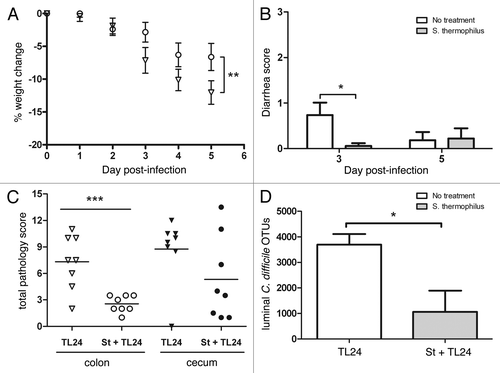Figures & data
Figure 1.Clostridium difficile growth is reduced by secreted components from Streptococcus thermophilus, namely lactic acid. (A) BHI media was supplemented with filtered supernatants from S. thermophilus (% v/v) or L-lactic acid (mM), inoculated (105 TL24) incubated for 16h and enumerated using plate counts; increased concentrations (75%) of filtrates or lactic acid (100mM) were bactericidal to C. difficile. Bacterial counts were comparable between control and 33% filtrate (p = 0.62), 20% filtrate (p = 0.52), 1mM lactic acid (p = 0.25) or 10mM (p = 0.052) using a student’s t-test. (B) Supernatants from C. difficile cultures supplemented with lactic acid exhibited dose-dependent decreases in TcdA/B. (C) Similarly, immunoblot analysis showed that TcdA levels decreased in the presence of S. thermophilus filtrates. (D) Decreased expression of tcdA compared with control 8h post-inoculation occurred in the presence of 10mM lactic acid. Results are displayed with standard errors of the mean.

Figure 2.C. difficile infection using TL24 in mice is reduced by treatment with S. thermophilus. (A) Weight change was calculated relative to day 0 weight for each mouse. S. thermophilus treated mice (circles; n = 18) lost significantly less weight (p = 0.004 using Wilks’ Lambda multivariate test) than untreated control mice (triangles; n = 19). Calculated data include final weights from mice that succumbed to infection or were euthanized for sample collection. (B) S. thermophilus treated mice had significantly less diarrhea than untreated mice (*p = 0.02 using an unpaired t-test) on day three, but not day five. (C) The colon of mice treated with S. thermophilus had significantly less pathology (***p = 0.0009 using a unpaired t-test) while cecal tissues from S. thermophilus treated mice showed less (p = 0.13) than untreated mice three days post-infection. (D) Cecal contents from mice treated with S. thermophilus had significantly less C. difficile operational taxonomic units (OTUs) (*p = 0.05; n = 3/group) compared with untreated mice from metagenomic based data.

Figure 3.S. thermophilus treatment increases levels of cecal lactate and is correlated with lower levels of C. difficile. (A) Antibiotic treated, uninfected mice receiving subsequent treatment with viable S. thermophilus had significantly higher levels of cecal lactate vs. mice receiving UV-irradiated (nonviable) S. thermophilus (***p = 0.0009; n = 3/group). (B) Mice treated with S. thermophilus before and after C. difficile infection maintained significantly higher cecal lactate levels (*p = 0.04) vs. untreated, infected mice. (C) An inverse correlation between cecal lactate and abundance of C. difficile OTUs from cecal luminal contents were calculated (two-tailed, Spearman r = -0.942, p = 0.017).
